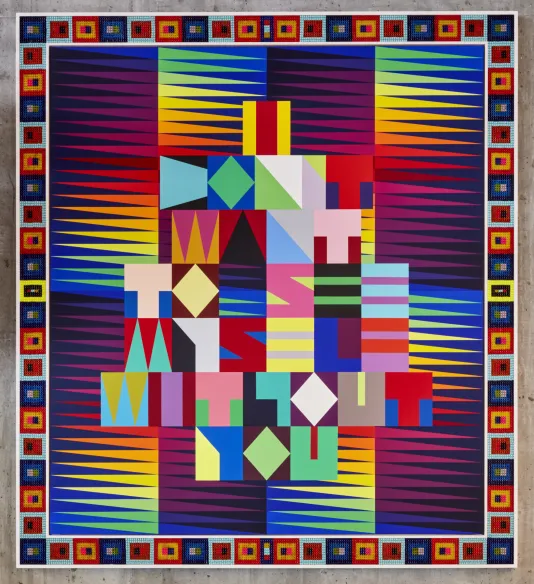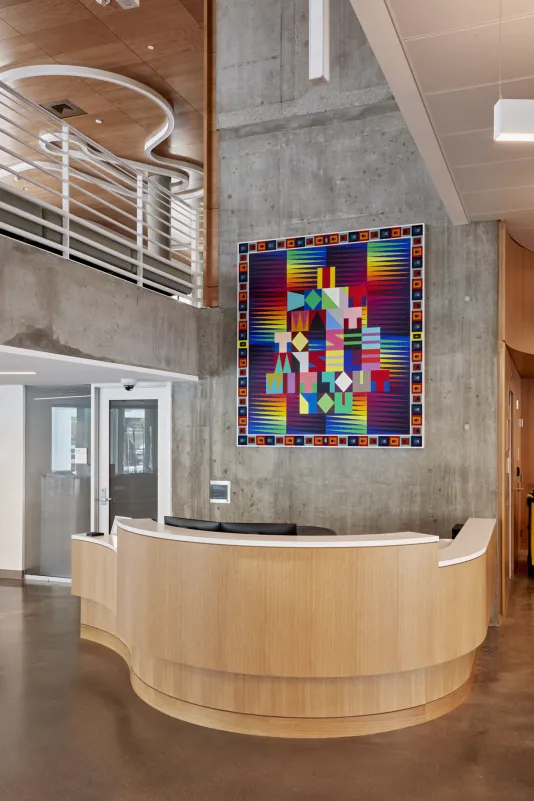Jeffrey Gibson, I DON'T WANT TO SEE MYSELF WITHOUT YOU, 2020. Commissioned with MIT Percent-for-Art funds. Photo: Charles Mayer Photography
I DON'T WANT TO SEE MYSELF WITHOUT YOU, 2020

Commissioned for the new Vassar Street Residence Hall, I DON’T WANT TO SEE MYSELF WITHOUT YOU welcomes students and visitors with dizzyingly hard-edge graphic letters that spell out the work’s title.
Surrounding this text, a dense pattern extends from the painting to its beaded frame, and adds to the work’s visual impact. In his multimedia paintings, quilts, sculptural objects, and garments, Jeffrey Gibson often engages geometric abstraction and its place in various art traditions, while also calling upon the practices and materials found in Indigenous handcraft and adopting techniques of weaving, quillwork, or beading, or incorporating materials such as elk hide canvases and sinew.
Gibson’s works bear even more wide-ranging references too, frequently touching on music or politics, or embracing a camp sensibility associated with queer nightlight subculture or the fluidity of gender. I DON’T WANT TO SEE MYSELF WITHOUT YOU is emblematic of Gibson’s tendency to appropriate phrases from lyrics found in pop, soul, or disco music, citing George Michael, Depeche Mode, Grace Jones, or, here, a song by folk-soul singer Terry Callier. United States’ history and settler colonialism are also subjects that inform the texts Gibson integrates in his works. His beaded wall-hanging American History (JB) (2015), for example, reads: “American history is longer, larger, more beautiful and more terrible than anything anyone has ever said about it.”
Throughout Gibson’s work, identity, culture, craft, and fine art are consistently exposed as entangled, interwoven, and embellished upon. For Gibson, Indigenous crafts and designs have “historically been used to signify identity, tell stories, describe place, and mark cultural specificity,” and yet his work invites viewers to think outside of specificity and to complicate their understanding of indigenous aesthetics and material histories.
Jeffrey Gibson (b. 1972) was born in Colorado Springs, CO and lives and works in New York. He earned his MA from the Royal College of Art, London, and his BFA from the School of the Art Institute of Chicago. Gibson is represented in the permanent collections of the Denver Art Museum, Museum of Fine Arts, Boston; Smithsonian Institution’s National Museum of the American Indian, National Gallery of Canada, Crystal Bridges Museum of American Art, Arkansas, and more. Gibson is on the Faculty at Bard College, and is a past TED Foundation Fellow, a Joan Mitchell Grant recipient, and a 2019 MacArthur Fellow. Gibson is a member of the Mississippi Band of Choctaw Indians and is of Cherokee descent.
